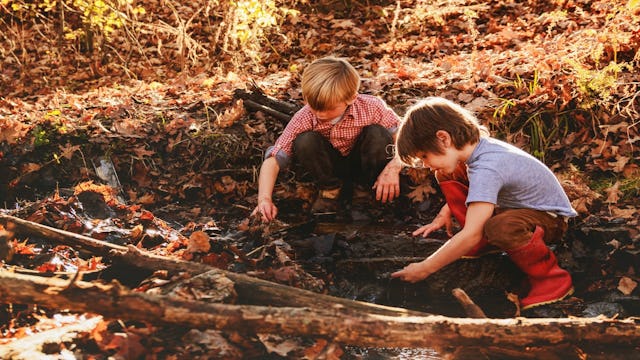Sensory Play Might Be Messy, But It’s Vital To Kids' Development

I grew up in the 90s, and for the most part, I came home from school, and then wandered the rivers and farms near my rural Utah home until the street lights came on. Before that, childcare more or less consisted of my parents kicking me out of the house and into the backyard of our one-acre lot to fend for myself.
And you know what? I learned a lot during those times. I learned how to get into to trouble and I learned how to get out of it. I also got pretty used to getting messy. I experienced grass, mud, rocks, and sunlight. I took in the smells of the farmland. And I loved it.
In contrast with how children are raised now, I don’t see them experiencing nearly has many of those sensory experiences. For example, just the other day I tried to kick my 10-year-old son out into our fenced in backyard, and he acted as if I was sending him off to live in the woods. He asked if he could take his tablet with him as though it were food and water.
I refused.
Like most parents, I don’t necessarily want another mess to clean up. Of course, we want to keep our children safe. But in this era of spic-and-span helicopter parenting, our children are beginning to miss out on sensory play.
On the Patagonia website (you know, the outdoor equipment people) is an except from Family Business by Malinda Chouinard and Jennifer Ridgeway that was published by The Great Pacific Child Development Center. It’s a pretty comprehensive look at what children can gain from sensory play, and it left me, as a parent, wondering if I’m actually losing out by keeping my children indoors where it’s clean and safe.
“Everything [children] see, hear, feel, touch, or even smell impacts their brain and thus influences the way they view and interact with their world—including their family, neighbors, strangers, friends, classmates, and even themselves,” said Daniel J. Siegel, a clinical professor of psychiatry at the UCLA School of Medicine and Executive Director of the Mindsight Institute.
There are multiple studies being done on the benefits of sensory play that are resulting in children getting back to those sensory basics previous generations grew up with. For instance, in a paper published in the journal Developmental Science, Larissa Samuelson, associate professor of psychology at the University of Iowa, along with a group of researchers, exposed several 16-month-olds to 14 non-solid objects. They mostly used food and drinks, anything from applesauce to pudding to juice. The children dove into everything they could, because, well, toddlers. They threw the food, mashed it, rubbed it into every available crevice — they probably did everything, but actually eat it. The study found that the “toddlers who interacted the most with the foods were more likely to correctly identify them by their texture and name them.”
Sensory play isn’t just good for development of the mind either; it’s also good for the body. According to Jack Gilbert, a scientist who studies microbial ecosystems at the University of Chicago and author of Dirt Is Good, children need more dirt in their lives to help them fully develop a strong immune system. During a recent interview with NPR, Gilbert answered a number of questions about the benefits of children coming into contact with germs. He feels the biggest mistake most parents make is to over-sterilize their child’s environment by preventing outdoor play. For example, when your 3-year-old goes into the backyard and gets a little muddy, the immediate reaction is to take her in and wash her off. But Gilbert says that’s not the best idea because it keeps children from exposure to germs that can really boost their immune system.
Roger Hart, professor of environmental psychology at the Graduate Center of the City University of New York discussed the new trend of junkyard playgrounds with CBS recently. These are playgrounds that more or less look like actual junkyards, where children are given the opportunity to build and destroy, to use tools with little supervision, and most importantly, to play without parental supervision and engage in a significant amount of sensory play.
Hart told CBS that “so much that’s positive in terms of intellectual development, social development, emotional development, physical development is best understood when understanding play. Play is a great indicator of health. … It’s where children create their world and learn to know themselves. Destructive and constructive play is a critical part in developing crucial motor and mental skills.”
Children can learn a lot by getting outside and getting dirty. Naturally it comes with simple and complex challenges, everything from as cleaning up messes, to the social stigma around unsupervised outdoor activity, but the fact is, there are benefits to sensory play. The article I mentioned above from the Patagonia website gives some great examples of how to get children involved in sensory experiences while also keeping them safe. I’m going to try some of them out. I suggest you do the same.
This article was originally published on